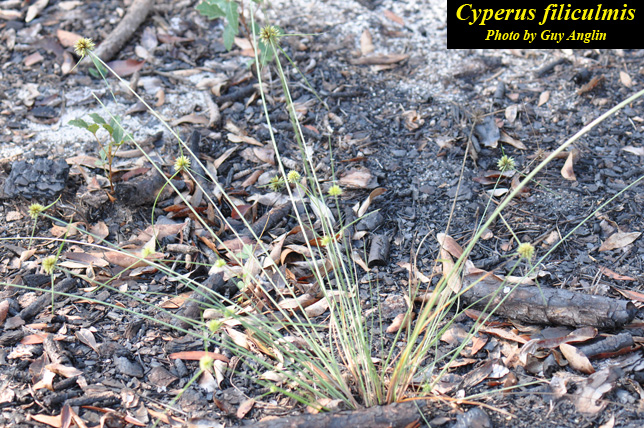Cyperus filiculmis
| Cyperus filiculmis | |
|---|---|

| |
| Photo by Guy Anglin, Atlas of Florida Vascular Plants | |
| Scientific classification | |
| Kingdom: | Plantae |
| Division: | Magnoliophyta - Flowering plants |
| Class: | Liliopsida – Monocotyledons |
| Order: | Poales |
| Family: | Cyperaceae |
| Genus: | Cyperus |
| Species: | C. filiculmis |
| Binomial name | |
| Cyperus filiculmis Vahl | |
Error creating thumbnail: Unable to save thumbnail to destination
| |
| Natural range of Cyperus filiculmis from USDA NRCS Plants Database. | |
Common name: southeastern flatsedge
Contents
Taxonomic notes
Synonyms: Cyperus lupulinus ssp. lupulinus[1]
Varieties: none[1]
Description
A description of Cyperus filiculmis is provided in The Flora of North America.
Distribution
C. filiculmus is native from southeast Maryland along the east coast south to southern peninsular Florida, and west to eastern Texas.[1]
Ecology
Habitat
Generally, Cyperus filiculmis can be found in forests, fields, and rocky or sandy woodlands.[1] It is found mainly in sandy soils, both wet and dry, including drying loamy sand, coarse sand, and moist sandy-peaty soil. It prefers sunny, open sites, and occurs in longleaf pine-wiregrass flatwoods and longleaf pine-turkey oak sand ridges. C. filiculumis is seen in disturbed habitats such as power line corridors, clear-cuts, and bulldozed or logged sites.[2] It is also common in low sand dunes.[3] A study on gopher tortoise (Gopherus polyphemus) found C. filiculmis to commonly grow on tortoise mounds in the late summer.[4]
Associated species includes Pinus palustris, Quercus laevis, and Aristidia stricta.[2]
Phenology
C. filiculmis has been observed both flowering and fruiting in May through November with peak inflorescence in June and August.[5][2] It is also known to flower between July and September.[1]
Seed dispersal
This species is thought to be dispersed by gravity.[6]
Seed bank and germination
A study focusing on the longleaf pine sandhill community found seeds of C. filiculmis to persist in the seed bank for up to 35 years either stratified or fresh with varying fire histories.[7]
Fire ecology
This species is fire tolerant, and has been observed in recently burned pine flatwoods,[2] and populations have been known to persist through repeated annual burning.[8]
Conservation, cultivation, and restoration
Cultural use
Photo Gallery
References and notes
- ↑ 1.0 1.1 1.2 1.3 1.4 Weakley, A.S. 2020. Flora of the Southeastern United States. Edition of 20 October 2020. University of North Carolina at Chapel Hill, Chapel Hill, North Carolina.
- ↑ 2.0 2.1 2.2 2.3 Florida State University Robert K. Godfrey Herbarium database. URL: http://herbarium.bio.fsu.edu. Last accessed: June 2014. Collectors: Loran C. Anderson, R. L. Lazor, R. K. Godfrey, R. F. Thorne, R. A. Davidson, S. W. Leonard, Gary R. Knight, Richard Carter, C. Jackson, J. B. McFarlin, R. Kral, Mabel Kral, J. B. McFarlin, Gwynn W. Ramsey, R. S. Mitchell, R. A. Norris, Steve L. Orzell, Richard Gaskalla, J. M. Kane, Cecil R. Slaughter, and Nancy Coile. States and Counties: Florida: Bay, Brevard, Calhoun, Citrus, Clay, Duval, Franklin, Gadsden, Gilchrist, Highlands, Leon, Liberty, Okaloosa, Polk, Sarasota, St. Johns, Suwannee, Taylor, and Wakulla. Georgia: Baker, Coffee, Liberty, and Thomas
- ↑ Dunlop, D. A. and G. E. Crow. (1985). "The vegetation and flora of the seabrook dunes with special reference to rare plants." Rhodora 87: 471-486.
- ↑ Kaczor, S. A. and D. C. Hartnett (1990). "Gopher tortoise (Gopherus polyphemus) effects on soils and vegetation in a Florida sandhill." American Midland Naturalist 123: 100-111.
- ↑ Nelson, G. PanFlora: Plant data for the eastern United States with emphasis on the Southeastern Coastal Plains, Florida, and the Florida Panhandle. www.gilnelson.com/PanFlora/ Accessed: 8 DEC 2016
- ↑ Kirkman, L. Katherine. Unpublished database of seed dispersal mode of plants found in Coastal Plain longleaf pine-grasslands of the Jones Ecological Research Center, Georgia.
- ↑ Parks, G. R. (2007). Longleaf pine sandhill seed banks and seedling emergence in relation to time since fire, University of Florida. Master of Science: 84.
- ↑ Glitzenstein, J. S., D. R. Streng, R. E. Masters, K. M. Robertson and S. M. Hermann 2012. Fire-frequency effects on vegetation in north Florida pinelands: Another look at the long-term Stoddard Fire Research Plots at Tall Timbers Research Station. Forest Ecology and Management 264: 197-209.